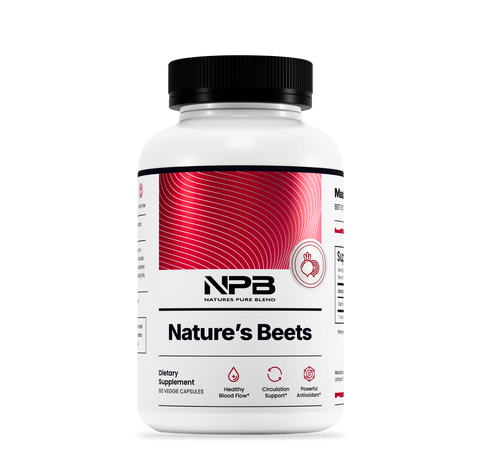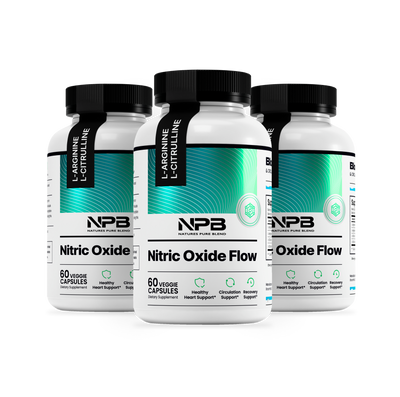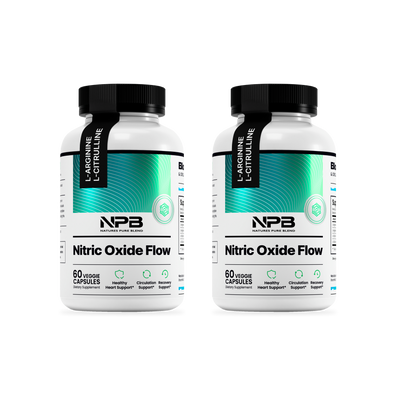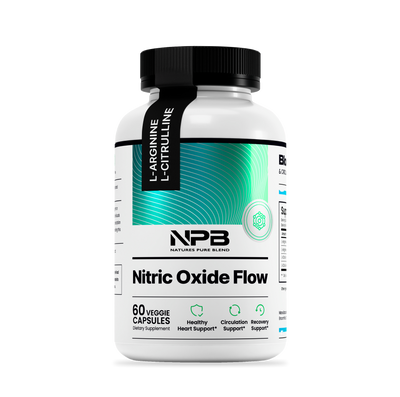Nitric oxide (NO) helps vessels relax and respond, supporting healthy blood pressure, smooth circulation, and better exercise tolerance. When NO output drops, vessels can feel “stiff,” recovery drags, and day-to-day stamina dips. The good news: a few repeatable habits can nudge NO production up—without overhauling your life.
Below are three evidence-backed levers, why they work, and how to put them into practice this week.
1. Eat Nitrate-Rich Vegetables (and Protect the Oral Microbiome)
Why it works: Leafy greens and beets deliver dietary nitrate → nitrite → nitric oxide via a pathway that depends on oral bacteria. This complements the body’s own NO synthesis and can support steadier readings and more responsive vessels. [1]
What to do:
-
Aim for 2 nitrate-rich servings daily: rotate arugula, spinach, romaine, beetroot, Swiss chard, celery.
-
Pair with vitamin C/polyphenols (citrus, berries, olive oil, herbs) to support NO availability.
-
Chew thoroughly—it increases nitrate reduction in the mouth.
-
Go easy on antiseptic mouthwash, which can reduce nitrate-reducing bacteria; if needed, time it away from your highest-nitrate meals.
Quick plate ideas:
-
Arugula–citrus salad with olive oil.
-
Roasted beets with lentils and herbs.
-
Smoothie: spinach + berries + yogurt/water.
2. Use Movement to Turn On Endothelial NO (eNOS)
Why it works: Rhythmic blood-flow “shear stress” from aerobic activity and brief bursts activates eNOS, the enzyme your vessels use to make NO. Strength training adds muscle—a major glucose sink—which supports the metabolic environment NO likes. [2]
What to do:
-
Post-meal walks: 10–15 minutes after your biggest carb meal (reduces spikes and supports vascular tone).
-
Zone 2 aerobic: 2–4 sessions/week, 30–45 minutes at a conversational pace (brisk walk, cycling, jog, rowing).
-
Short intervals (optional): 1–2×/week, e.g., 6–8 × 30 sec hard / 90 sec easy after a warm-up.
-
Strength training: 2–3 days/week (push, pull, squat, hinge, carry; 2–4 sets of 6–12 reps).
Form the habit: Put a 15-min walk on your calendar right after dinner and block two 40-minute Zone 2 slots mid-week.
3. Supply Precursors & Protect NO From Oxidative Stress
Why it works: Your cells generate NO from L-arginine/L-citrulline, and antioxidants help preserve NO by limiting excessive oxidative stress. [3], [4]
What to do (food-first):
-
Arginine sources: poultry, fish, beans/lentils, pumpkin seeds, peanuts.
-
Citrulline source: watermelon (especially the lighter flesh near the rind).
-
Polyphenols & vitamin C: berries, citrus, kiwifruit, cocoa, green/black tea, extra-virgin olive oil, colorful vegetables.
-
Magnesium & potassium: leafy greens, beans, nuts, yogurt, potatoes—minerals that support vascular tone.
Easy daily combo:
-
Breakfast: oats + berries + yogurt.
-
Lunch: bean-and-greens bowl with olive-oil vinaigrette.
-
Snack: a handful of nuts or pumpkin seeds.
-
Dinner (2×/week): salmon or trout with roasted beets and greens.
-
Dessert swap (in season): a bowl of watermelon.
7-Day “NO-Boost” Mini Plan
-
Daily: 2 nitrate-rich veggie servings + a 10–15-minute post-meal walk.
-
3×/week: full-body strength session (30–45 min).
-
2–3×/week: Zone 2 cardio (30–45 min); add one short interval finisher if you’re already active.
-
All week: prioritize sleep (7–9 hrs), morning daylight, and steady hydration.
How to Track Progress (without obsessing)
-
BP (home): AM and PM, two readings 1 minute apart, average them (proper posture, arm at heart level).
-
Energy & stamina: 0–10 rating mid-afternoon and after workouts.
-
Walk consistency: yes/no after your largest carb meal.
-
Notes: mouthwash timing, alcohol, unusual stress, or poor sleep—anything that might blunt NO.
Bottom line
Support nitric oxide from both directions: feed the nitrate pathway (greens + beets), turn on eNOS with consistent movement, and supply/protect precursors with smart food choices. Keep it simple, repeat it daily, and let your log—energy, recovery, and well-measured BP—show you the trend over the next 2–4 weeks.















